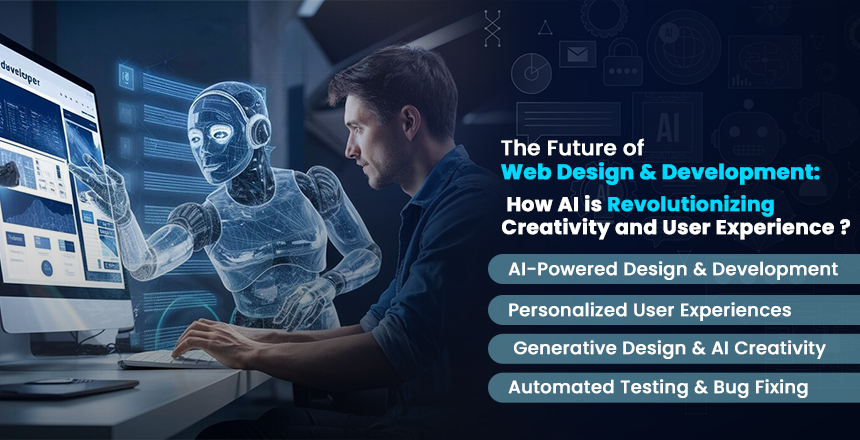Web design and development trends have a significant influence on how businesses engage with users, build their online presence, and deliver digital experiences. In 2024, these trends are expected to push boundaries further, offering more personalized, interactive, and immersive experiences to capture the ever-shortening attention spans of users. Whether you're a seasoned developer or a business owner looking to enhance your digital strategy, these seven trends are crucial to success in the coming year.
AI-Powered Design and Development
Artificial intelligence (AI) is reshaping industries across the board, and web design and development are no exception. In 2024, AI tools will further streamline the process of building websites, from generating code snippets to creating entire layouts and user interfaces.
AI in Web Design: AI can analyze user preferences and behavioral patterns to recommend design elements like colors, fonts, and layouts that are most likely to convert visitors. Tools like Adobe Sensei or The Grid use AI algorithms to automatically generate responsive web designs, making the process faster and more efficient.
AI in Web Development: AI can also write code, conduct automated testing, and even detect bugs, freeing up developers to focus on more creative and strategic tasks. GPT models and AI-based coding assistants like GitHub Copilot are making development smoother and error-free, further lowering the entry barrier for budding developers.
Voice User Interface (VUI) and Voice Search Optimization
With the increasing popularity of virtual assistants like Alexa, Siri, and Google Assistant, voice search is becoming a mainstream way to access information. Optimizing websites for voice search and VUI will be a game-changer in 2025.
Voice Search Optimization: People using voice search often phrase their queries differently than they do in text-based searches. This means that websites need to be optimized for long-tail, conversational keywords and provide structured data for search engines to better understand content.
Voice User Interfaces: More websites are integrating VUIs, allowing users to navigate through voice commands. This trend is especially important for enhancing accessibility, as it provides an easier way for users with disabilities to interact with websites.
Neumorphism and Glassmorphism Design Trends
2025 will continue to see shifts in aesthetic trends, with neumorphism and glassmorphism emerging as the frontrunners in web design.
Neumorphism: A blend of skeuomorphism (design that mimics real-world objects) and flat design, neumorphism creates interfaces that appear soft, subtle, and tactile, providing depth through shadowing and highlights. This style enhances the UX by creating intuitive, familiar buttons and input fields, giving users a more engaging experience.
Glassmorphism: Characterized by frosted-glass elements and transparency, glassmorphism brings a clean, futuristic look to websites. Paired with vibrant colors and gradients, this trend offers a modern, minimalist aesthetic that many brands will adopt for 2024. These design choices create an illusion of depth, making pages feel dynamic without being too cluttered.
Neumorphism and Glassmorphism Design Trends
2025 will continue to see shifts in aesthetic trends, with neumorphism and glassmorphism emerging as the frontrunners in web design.
Neumorphism: A blend of skeuomorphism (design that mimics real-world objects) and flat design, neumorphism creates interfaces that appear soft, subtle, and tactile, providing depth through shadowing and highlights. This style enhances the UX by creating intuitive, familiar buttons and input fields, giving users a more engaging experience.
Glassmorphism: Characterized by frosted-glass elements and transparency, glassmorphism brings a clean, futuristic look to websites. Paired with vibrant colors and gradients, this trend offers a modern, minimalist aesthetic that many brands will adopt for 2024. These design choices create an illusion of depth, making pages feel dynamic without being too cluttered.
5G and Progressive Web Apps (PWAs)
As 5G technology becomes more accessible worldwide, it’s pushing the boundaries of what’s possible in terms of speed and responsiveness. This fast internet connectivity, combined with Progressive Web Apps (PWAs), will redefine user expectations for online experiences in 2025.
5G for Web Development: With 5G, data-heavy applications, video streaming, AR/VR elements, and interactive animations will load faster than ever, providing a seamless, lag-free experience for users. Web developers will need to optimize sites for these enhanced capabilities, ensuring their websites don’t just work faster but also incorporate high-quality, engaging content.
Progressive Web Apps (PWAs): PWAs combine the best features of websites and mobile apps, such as offline functionality, push notifications, and home screen shortcuts, without the need for an app store. With 5G speeds, PWAs will be able to deliver more complex functionalities and smoother performance, driving more businesses to adopt them for mobile-friendly experiences.
Augmented Reality (AR) and Virtual Reality (VR) Integration
AR and VR are no longer reserved for the gaming industry. In 2025, expect to see more websites incorporating these technologies to create immersive, interactive experiences that captivate users.
AR in Web Design: With AR, users can interact with digital elements overlaid on the real world. Retail websites, for example, can allow customers to “try on” clothes or visualize furniture in their homes before purchasing. This creates an engaging and highly personalized user experience, increasing conversion rates.
VR for Immersive Experiences: Virtual reality can transport users to entirely new environments, which can be useful for real estate, travel, and education websites. Incorporating VR into web design can set a brand apart by offering an experience that goes beyond traditional 2D interfaces.
Sustainability in Web Development
The environmental impact of digital technology is increasingly coming under scrutiny, with websites playing a significant role in energy consumption due to data centers, servers, and continuous streaming. In 2025, a growing number of developers will adopt sustainable web development practices.
Eco-friendly Websites: Reducing page load times, optimizing media, and streamlining code are just a few of the ways to decrease a website’s energy consumption. Tools like Website Carbon Calculator help developers measure and minimize a site's carbon footprint. Many brands are also choosing green hosting services that rely on renewable energy.
Sustainable UX/UI Design: Sustainability extends to design as well. Minimalist design not only reduces load times but also cuts down on energy use. By embracing simplicity in design elements and interactions, developers can enhance both sustainability and user experience.
Low-Code and No-Code Development
The rise of low-code and no-code platforms will continue to democratize web development in 2025, enabling non-developers to create websites and apps with minimal technical expertise.
Low-Code Platforms: These platforms allow developers to use visual interfaces and pre-built modules to accelerate the development process. Low-code solutions are particularly useful for rapidly prototyping applications, building internal tools, and automating workflows.
No-Code Platforms: No-code tools like Webflow, Wix, and WordPress enable people without coding skills to build and maintain websites easily. In 2024, more businesses will leverage these platforms to reduce the cost of development and empower teams to manage content, updates, and changes without relying on a developer.
Conclusion
Staying ahead of the curve in web design and development requires embracing innovation while also keeping user experience at the forefront. AI-powered design, voice interfaces, immersive AR/VR experiences, and sustainability practices will define 2024, shaping the way businesses connect with their audiences online. As these trends continue to evolve, those who adapt and innovate will unlock new opportunities for engagement, growth, and success. Whether you’re developing your first website or refining a complex digital ecosystem, these seven trends will help you navigate the rapidly changing digital landscape and emerge as a leader in your industry.










